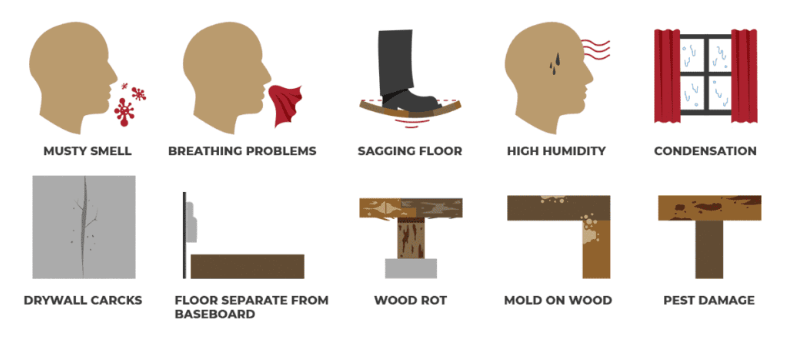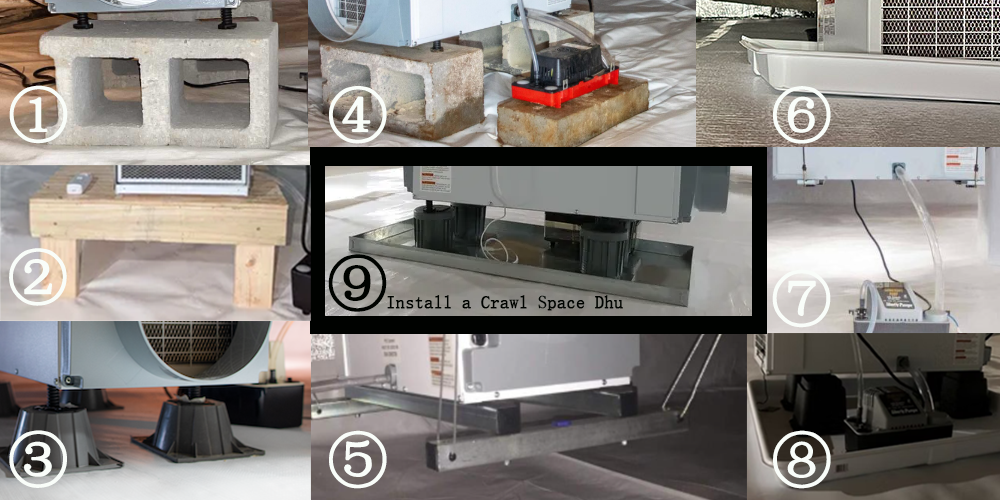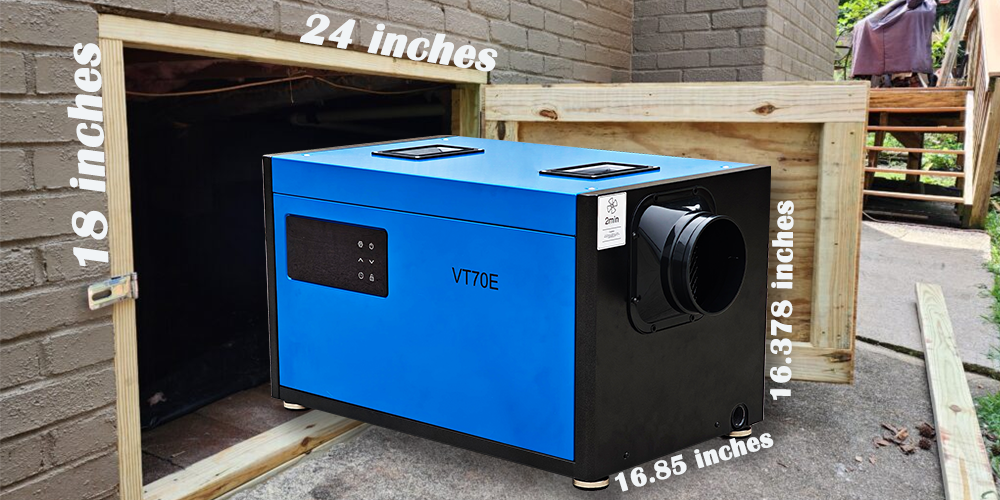Residential and commercial buildings typically have crawl spaces because they are both cost-effective and convenient. On the other hand, crawl spaces are often damp, dirty, and dimly lit. This article will explain how to keep the crawl space dry, the cost of a dehumidifier, and how to select and install a dehumidifier.
How to Keep the Crawl Space Dry and Comfortable?
The damp crawl space is an ideal place for mold growth. This is already bad enough, but the situation is even worse. A certain proportion of air in the crawl space will enter the living area of your home. In other words, you are breathing unhealthy air, which can exacerbate or even lead to various health problems.
Moisture in the crawl space can also cause wood to rot, damaging beams and supports, and potentially leading to structural problems.
Due to the increased cost of heating and cooling humid air, energy costs also increase.
Fortunately, by using a crawl space dehumidifier and crawl space packaging, a clean and dry crawl space can be achieved.
Do you want your crawl space to be as dry as possible? If that's the case, then adopting sealing technology and installing a crawl space dehumidifier and drainage system is the best choice. It can be said that this is the ultimate waterproof solution.

Cost Of Crawl Space Encapsulation With A Dehumidifier
The cost of packaging with a crawl space dehumidifier depends on multiple factors, including the size of the crawl space and the geographical area. Generally speaking, in service areas of Nebraska, Iowa, Kansas, and Missouri, the cost of using a crawl space dehumidifier for packaging ranges from $ 5,000 to $ 20,000 or even higher, depending on the size of the crawl space and whether a drainage system is installed.
Only with careful maintenance can the crawl space dehumidifier perform at its best. If not maintained regularly, dirt can clog the drainage pipes. This will increase the operational burden of the dehumidifier, but the actual effect will decrease. The humidity does not remain constant throughout the year. It will rise, fall, and change with weather changes, causing your house to be exposed in different ways.
That's why seasonal maintenance is so important. Each season of the year brings different humidity challenges, and preparing a dehumidifier in advance can ensure that it can withstand the load.
How Big Is a Standard Crawl Space?
The International Residential Code (IRC) has established a series of building construction rules. These regulations ensure that buildings are clean, safe, and convenient for people's work and life. Although IRC does not mandate local government agencies to comply with these regulations, many places use them as a guide for developing building codes.
According to IRC regulations, all access doors in crawl spaces must be convenient for emergencies or maintenance. The standard size for crawl space doors is 18x24 inches. But the entrance must be at least 16 inches high and 24 inches wide.
Evaluate Various Installation Methods of the Dehumidifier
As a dehumidifier manufacturer with many years of experience, Preair has received much feedback from distributors regarding the use of crawl space dehumidifiers. At first, we were puzzled as to why some users of the same batch of products would encounter problems while others did not complain. This problem is mainly manifested as internal water leakage of the dehumidifier (caused by many reasons, not discussed here), with an unbroken drainage pipe. And the dehumidifier is soaked in a "water pit", causing severe failure. After in-depth communication with the users and studying the on-site photos and videos, we found a common cause of malfunction, which is improper installation. Regarding this point, this article will provide specific explanations based on the collected installation renderings of dehumidifiers.

As shown in the figure,
Method 1: Place the dehumidifier on hollow bricks and place the water pump on the nearby ground.
The machine is placed horizontally, about 5 inches above the ground. Hollow bricks are a common building material, and there will be a surplus on construction sites. Using them as a foundation is a "waste utilization", which is environmentally friendly and cost-effective. However, there is a risk of the water pump being soaked by accumulated water.
Method 2: Place the dehumidifier on a low-legged wooden frame and place the water pump on the nearby ground.
The machine is placed horizontally, about 5 inches above the ground. Specially made wooden frames undergo anti-corrosion and reinforcement treatment, and the cost is not high. However, if the environmental humidity is high and the dehumidifier leaks water, the service life of the wooden frame will be greatly reduced. There is also a risk of the water pump being soaked by accumulated water.
Method 3: Install specialized plastic bases on the four support points of the dehumidifier, and place the water pump on the nearby ground.
The machine is placed horizontally, about 5 inches above the ground. The plastic base is sturdy, durable, and specially designed for the product, and the cost is generally included in the total price. In addition, there is a risk of the water pump being soaked by accumulated water.
Method 4: Place both the dehumidifier and water pump on hollow bricks.
The powered machinery is placed horizontally, about 5 inches above the ground. There is no risk of being soaked by accumulated water. Hollow bricks are readily available, environmentally friendly and cost-effective.
Method 5: Hoist the dehumidifier away from the ground and walls.
The machine remains level in mid-air, and there is no risk of being soaked by accumulated water. Ceiling equipment needs to be purchased separately and requires professional installers to work on-site. If these additional costs are not considered, this installation method is more convenient for the later maintenance of the machine.
Method 6: Place the dehumidifier in a water tray.
The machine is placed horizontally. However, if there is water leakage from the machine, it will be surrounded by the accumulated water in the tray.
Method 7: Hoist the dehumidifier and place the water pump on the nearby ground.
The machine remains level in mid-air, and there is no risk of being soaked by accumulated water. However, the water pump is likely to get wet from droplets.
Method 8: Install specialized plastic bases on the four support points of the dehumidifier, along with the water pump, and place them in a water tray.
The machine is placed horizontally, about 5 inches above the ground. There is a risk of the water pump being soaked by accumulated water.
Method 9: Install specialized plastic bases on the four support points of the dehumidifier, and then place it in a water tray.
The machine is placed horizontally, about 5 inches above the ground. In case of water leakage from the machine, the water can directly flow into the tray and avoid scattering onto the ground. There is no chance of the water damaging the machine and other equipment. A water tray and four plastic bases are generally provided by the manufacturer, and the cost is included in the selling price. If there are no related accessories, end users need to purchase additional ones.
Preair summarizes several valuable experiences from practical problems reported by users and the corresponding suggestions of our engineers. The dehumidifier should be placed horizontally in an encapsulated crawl space, about 5 inches above the ground/installed on the ceiling, and a water tray is recommended. By the way, the crawl space dehumidifier produced by the Preair factory has a level gauge on the casing for horizontal placement and installation. When an external water pump is required (since some dehumidifiers do not have a built-in pump), it should be placed at a high level. Therefore, Methods 4, 5, and 9 are better. Among them, Method 9 is the most recommended choice because it further prevents the dispersion of water.
Learn more about our company through videos…
Post time: Oct-28-2025


